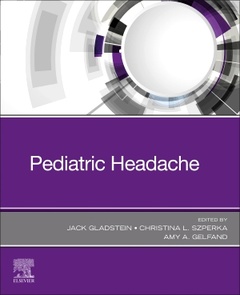Description
Pediatric Headache
Authors: Gladstein Jack, Szperka Christina L., Gelfand Amy A.
Language: English
Subjects for Pediatric Headache:
Keywords
<; P>; Headache; migraine; Children; Adolescents; Neurology; Pediatrics<; /P>
98.28 €
In Print (Delivery period: 14 days).
Add to cart378 p. · 19x23.4 cm · Paperback
Description
/li>Contents
/li>Biography
/li>
Offers concise guidance on diagnosis and treatment of pediatric headache from both a primary care and neurologist's point of view.
Covers traditional treatment options such as medication, devices, and behavioral interventions as well as sleep, diet, exercise, and stress management recommendations.
Discusses the important issue of patient advocacy for providers and families.
Provides support for school-age patients with samples of school letters and other patient material resources for providers to share with families.
Enhanced eBook version included with purchase. Your enhanced eBook allows you to access all of the text, figures, and references from the book on a variety of devices.
1. My headache appointment: A guide for parents, primary care and specialists
PART II. WHY DOES MY HEAD HURT?
2. You're not the only one (epidemiology)
3. Pathophysiology of migraine
4. Genetics of migraine
PART III. HOW DID IT GET SO BAD?
5. The "Episodic Syndromes: i.e. what migraine looks like before it "looks like migraine
6. Effect of hormones
7. Chronic migraine and other types of chronic daily headache
8. Comorbidities in children and adolescents
9. NDPH: What a primary care provider/ headache specialist needs to know
10. Post-Traumatic Headaches in Youth
11. POTS and dysautonomia
PART IV. WAYS OTHER PEOPLE CAN HELP ME GET BETTER
Section 1. Treatments for when symptoms are acting up
12. Meds
13. Acute Behavioral Headache Management
14. What should I expect when home therapy does not work
Section 2. Treatments for trying to settle down frequency
15. Preventive treatments: Oral
16. Preventive Injections
17. Behavioral interventions to improve frequency
Section 3. Treatments that can act both acutely and preventively
18. Devices
19. CGRP
20. Non-medication treatments including acupuncture
PART V. HOW CAN I GET BETTER? THINGS I CAN DO FOR MYSELF/MY CHILD
21. Sleep and Headache in Children and Adolescents
22. Meals/Food/Diet/Caffeine/Hydration
23. Activity/Exercise including Yoga
24. Managing Migraine at School
25. How you can get more involved: a guide for families and clinicians
26. Growing up: Transitioning to adult care
PART VI. NEXT STEPS
27. How to set up a headache clinic
28. Where can I learn more? A listing of resources
Christina Szperka, MD, MSCE, has been interested in the treatment of chronic pain since she was an undergraduate at Amherst College, Amherst, MA, and focused on pediatric pain while pursuing her medical degree at Yale University School of Medicine, New Haven, CT. Dr. Szperka completed residencies in pediatrics and child neurology at The Children's Hospital of Philadelphia, Philadelphia, PA, and a fellowship in headache medicine at The Jefferson Headache Center at Thomas Jefferson University Hospital. She is board certified in Headache Medicine.
She divides her time between patient care and projects aimed at improving the treatment of children with headaches. In 2013, she was named director of the newly formed Pediatric Headache Program. She has received grants to improve clinical care of and treatment options for headache.
Dr. Amy Gelfand is an Associate Professor of Neurology & Pediatrics at the University of California, San Francisco. She directs the Child & Adolescent Headache Program at the UCSF Benioff Childrens' Hospitals. Her research interests include examining the role of melatonin in the treatment of pediatric migraine, and the relationship between




